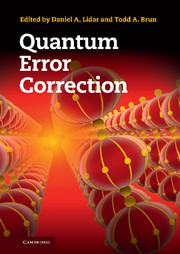Book contents
- Frontmatter
- Contents
- List of contributors
- Prologue
- Preface and guide to the reader
- Acknowledgements
- Part I Background
- 1 Introduction to decoherence and noise in open quantum systems
- 2 Introduction to quantum error correction
- 3 Introduction to decoherence-free subspaces and noiseless subsystems
- 4 Introduction to quantum dynamical decoupling
- 5 Introduction to quantum fault tolerance
- Part II Generalized approaches to quantum error correction
- Part III Advanced quantum codes
- Part IV Advanced dynamical decoupling
- Part V Alternative quantum computation approaches
- Part VI Topological methods
- Part VII Applications and implementations
- Part VIII Critical evaluation of fault tolerance
- References
- Index
4 - Introduction to quantum dynamical decoupling
from Part I - Background
Published online by Cambridge University Press: 05 September 2013
- Frontmatter
- Contents
- List of contributors
- Prologue
- Preface and guide to the reader
- Acknowledgements
- Part I Background
- 1 Introduction to decoherence and noise in open quantum systems
- 2 Introduction to quantum error correction
- 3 Introduction to decoherence-free subspaces and noiseless subsystems
- 4 Introduction to quantum dynamical decoupling
- 5 Introduction to quantum fault tolerance
- Part II Generalized approaches to quantum error correction
- Part III Advanced quantum codes
- Part IV Advanced dynamical decoupling
- Part V Alternative quantum computation approaches
- Part VI Topological methods
- Part VII Applications and implementations
- Part VIII Critical evaluation of fault tolerance
- References
- Index
Summary
Motivation and overview
The aim of this chapter is to illustrate the basic physical principles and mathematical framework of dynamical decoupling (DD) techniques for open quantum systems, as relevant to quantum information processing (QIP) applications. Historically, the physical origins of DD date back to the idea of coherent averaging of interactions, as pioneered in high-resolution solid-state nuclear magnetic resonance (NMR) by Haeberlen and Waugh using elegantly designed multiple-pulse sequences [HW68, WHH68, H76]. It was in the same landmark work [HW68] that average Hamiltonian theory was developed as a formalism on which the design and analysis of DD sequences has largely relied since then. In the original context of NMR spectroscopy, decoupling serves the purpose of enhancing resolution by simplifying complex spectra. This is achieved by realizing that an otherwise static spin Hamiltonian “can be made to appear time-dependent in a controlled way,” so that “as the characteristic repetition period of the pulses becomes [sufficiently] small, the spin system comes to behave over long times as though under the influence of a time-independent average Hamiltonian” [HW68]. Some basic insight may be gained by revisiting the paradigmatic example offered by the so-called Hahn echo [H50] and Carr–Purcell (CP) sequences [CP54] in the simplest setting of a two spin-1/2 system.
- Type
- Chapter
- Information
- Quantum Error Correction , pp. 105 - 125Publisher: Cambridge University PressPrint publication year: 2013
- 1
- Cited by

